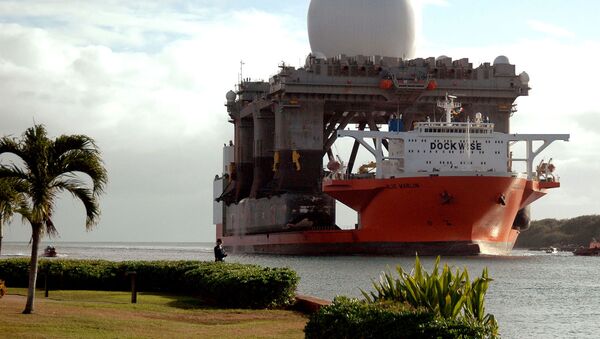The massive vessel, built on a modified oil rig, is affectionately known by Hawaiians as the “golf ball ship” thanks to its massive, white, spherical radome. SBX returned to the Naval Station Pearl Harbor earlier this week, following an extended stay at sea, for routine maintenance and upgrades, Missile Defense Agency spokesperson Maria Njoku said.
“As of now SBX has been at sea for more than 500 days without a port visit,” Michelle Atkinson, the MDA’s acting director of operations, said at a March Pentagon press conference. “The [fiscal 2020] program continues to provide extended SBX sea time to maintain its important contribution to homeland defense.”
The Pentagon has a use for SBX until at least 2024, when a series of new missile defense radars are due to come online that will be far more reliable than SBX, which has a narrow scope of observation and must be shuttled back and forth from its operation location to its home port.
"With the addition of the long-range discriminating radar in Alaska, the homeland defense radar in Hawaii and the future Pacific radar, we will have in place a diverse sensor architecture in the Pacific to provide an improved and persistent" missile-tracking capability, former Missile Defense Agency Director Lt. Gen. Sam Greaves told Congress in April, AP noted.
“Something like SBX will remain an important asset in the near term, to have a defense-and-defeat dominant posture toward North Korea,” Thomas Karako, director of the Missile Defense Project at the Center for Strategic and International Studies (CSIS), told the Honolulu Star-Advertiser Monday. “In the longer term, however, adapting to Russia and China will require a much different solution set than a chain of surface-based radars, capable as they are.”
Karako noted the US might “consider accepting greater risk with North Korea and moving with all deliberate haste toward a robust space sensor layer capable of tracking both ballistic missiles and hypersonic gliders.”
“Nearly all of our adversaries are concerned with US missile defenses and have devised various means to complicate missile defense operations,” the MDA wrote in March 2019 in its Fiscal Year 2020 budget estimates. “Many foreign ballistic and cruise missile systems are progressively incorporating advanced countermeasures, including maneuverable reentry vehicles, multiple independent reentry vehicles, and electromagnetic jamming, all intended to defeat our missile defense capabilities.”
The $1 billion Homeland Defense Radar-Hawaii is scheduled to come online in 2023, and the Navy’s AN/SPY-6 missile defense radar, which is 30 times more powerful and sensitive than the SPY-1 radars it will replace on US Navy destroyers, is due to enter service the same year. The AN/SPY-6 has cost the Navy $385 million just to develop, and each radar system is projected to cost an additional $300 million, according to 2013 Government Accountability Office estimates.
Until then, though, the SBX will have to shoulder the burden of monitoring “continued missile test activity in North Korea.” The MDA wants the platform back at sea by October and to spend at least 300 days at sea during each of the next four years, the Star-Advertiser reported.
All those radars tie into 44 ground-based interceptors in Alaska and California that would then intercept the incoming projectiles.
However, the SBX might be shipped to the Atlantic in the future as the Pacific radars come online and if tensions continue to heat up with Iran, Riki Ellison, chairman of the Missile Defense Advocacy Alliance, told the Star-Advertiser.


